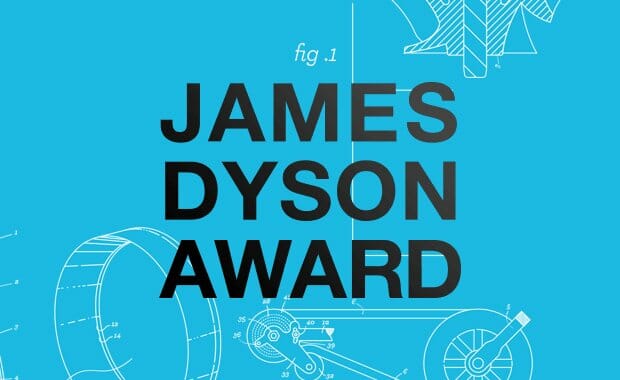Inspired by a NASA space rover, two young inventors from Chile and Kenya want to generate electricity in windy cities
The James Dyson Award is an international design award that celebrates, encourages and inspires the designers of new problem-solving ideas.
It’s open to current and recent design engineering students, and is run by the James Dyson Foundation, James Dyson’s charitable trust, as part of its mission to get young people excited about design engineering.
The competition is open to designers who think differently, to create products that work better. Winning solutions are selected by Sir James Dyson based on ingenuity, iterative development and commercial viability.

From climate change, to poverty, global issues increasingly demand collaborative, cross-cultural responses. Originating from Chile and Kenya respectively, Nicolas Orellana and Yaseen Noorani represent a new era of talent that are working together to develop technologies that are capable of tackling our shared problems. Studying International Innovation MSc together at Lancaster University, they set out to harness urban wind with an inventive new type of turbine. But what’s the problem with wind?
The taller we build our cities, the windier they become. As we hunt for renewable sources of power generation this powerful and plentiful resource is left untapped largely because traditional wind turbines only capture wind travelling in one direction. This means they are very inefficient in cities where the wind is unpredictable and multi-directional.
When wind blows through cities it becomes trapped between buildings, is dragged down to the street and is pushed up into the sky. This catapults wind into chaos, which renders conventional turbines unusable. Using a simple geometric shape, O-Wind Turbine is designed to utilise this powerful untapped resource, generating energy even on the windiest of days.
Sir James Dyson said: “Design something that solves a problem is an intentionally broad brief. It invites talented, young inventors to do more than just identify real problems. It empowers them to use their ingenuity to develop inventive solutions. O-Wind Turbine does exactly that. It takes the enormous challenge of producing renewable energy and using geometry it can harness energy in places where we’ve scarcely been looking – cities. It’s an ingenious concept.”
Nicolas Orellana first became interested in the challenge of multidirectional wind after studying NASA’s Mars Tumbleweed Rover. Six feet in diameter, this inflatable ball was designed to autonomously bounce and roll like tumbleweed, across Mars’ surface to measure atmospheric conditions and geographical location. Like conventional wind turbines, it was powered by unidirectional wind blows which severely impaired the rover’s mobility when faced with obstructions, often throwing it off course and resulting, ultimately, in the failure of the project.
By exploring the limitations of the Tumbleweed, Nicolas’s three-dimensional wind turbine technology was born. Nicolas and his fellow student Yaseen Noorani soon identified how cities could use this technology to harness energy to produce electricity.
How does O-Wind Turbine work?
O-Wind Turbine is a 25cm sphere with geometric vents; it sits on a fixed axis and spins when wind hits it from any direction. When wind energy turns the device, gears drive a generator which converts the power of the wind into electricity. This can either be used as a direct source of power, or it can be fed into the electricity grid. Nicolas and Yaseen aim for O-Wind Turbine to be installed to large structures such as the side of a building, or balcony, where wind speeds are at their highest.
Nicolas Orellana said: “We hope that O-Wind Turbine will improve the usability and affordability of turbines for people across the world. Cities are windy places but we are currently not harnessing this resource. Our belief is that making it easier to generate green energy, people will be encouraged to play a bigger own role in conserving our planet. Winning the international James Dyson Award has validated our concept. The attention we’ve received so far has been humbling and given us the confidence to see the development of this concept as a future career. Already we are in discussions with investors and we hope to secure a deal in the coming months.”
Harry Hoster, Director of Energy Lancaster at Lancaster University advised and supported the team in the design process.
He said: “When the two students first approached us about test facilities for a new wind turbine design, we first thought it would just be the 23rd variation of some plain vanilla system. When they humbly showed their video and their prototype, however, we were, excuse the pun, blown away. Only holding it in your hands and playing with it gives you a chance to understand what their new device actually does and how, if things go right, its ability to capture any random breezes will take urban energy harvesting to another level.”
Wind power in cities
Singapore’s first long-span wind turbine was installed at Semakau landfill on 20 October. It stands 14 storeys tall, features three long-span rotor blades, and is capable of generated enough energy to power 45 four-room HDB units a year.
Over half of the world’s population now live in cities according to the UN, a number which is growing as more and more nations urbanise rural areas, and densify their towns. Chicago, the home of the world’s first ever skyscraper, is widely known as ‘the windy city’. Wellington in New Zealand is the world’s windiest city, and Punta Arenas in Chile, one of the world’s windiest cities.
The Mars Tumbleweed Rover
The idea of sending a spherical, wind-propelled vehicle (or “Mars Ball”) to the Red Planet was originally conceived in 1977 by Jacques Blamont of NASA’s Jet Propulsion Laboratory (JPL) and the University of Paris. Since then the concept evolved in the Mars Tumbleweed rover. This is a concept for a lightweight, spherical, deployable structure, with a configuration that maximises drag to capture the Martian wind for mobility and extended mission duration. Its core purpose is to survey the Red Planet, to provide vital information that could improve future exploration.[3]
It was first tested in 2000 in California’s Mojave Desert, and in 2004, the Jet Propulsion Laboratory’s rover embarked on trek across the South Pole. This included a seven-day, 80-mile journey across Antarctica where it averaged about 3.7 miles per hour. Although the project continues to inspire scientists, consensus on its design has yet to be reached.
The James Dyson Award
Every year, James Dyson Award gives students and recent graduates of engineering and design the unique opportunity to show their problem solving inventions on a global stage. The brief is simple, design something which solves a problem, big or small.
Winning solutions are selected by Sir James Dyson and show ingenuity, iterative development and commercial viability. This year Mexico, the UAE, Sweden and the Philippines, have joined the global contest. With students from 27 nations now competing, the award has welcomed new approaches to a broader range of global issues than ever before.









